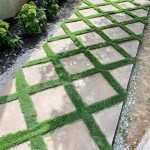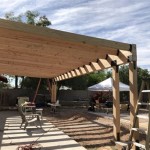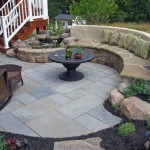Cost Considerations for a Concrete Patio Slab
A concrete patio slab represents a durable and versatile outdoor living space solution. Determining the cost of such a project involves analyzing several interconnected factors. The overall price fluctuates based on the patio's size, the concrete's thickness, the complexity of the design, site preparation requirements, labor rates, and regional material costs. Understanding these cost variables is critical for homeowners seeking to budget and plan effectively.
Size and Thickness of the Concrete Patio
The size of the patio slab directly impacts the total material costs. A larger patio naturally requires more concrete volume, which will translate to a higher expenditure. Concrete is often priced per cubic yard. Therefore, calculating the surface area of the patio is the first step in determining the volume of concrete needed. Multiplying the length and width of the patio in feet and then dividing by 27 will give you the surface area in cubic yards.
The thickness of the concrete slab is also a significant cost driver. Standard residential patios typically range from 4 to 6 inches in thickness. A 4-inch slab is usually sufficient for pedestrian traffic and light furniture. However, if the patio will support heavier loads, such as a hot tub or vehicles, a 6-inch or thicker slab is recommended. Increasing the thickness directly increases the concrete volume required, thus raising the cost. For example, a patio that is 20 feet by 20 feet requires 5 cubic yards of concrete for a 4-inch thickness, but requires 7.4 cubic yards for a 6-inch thickness.
Beyond the raw concrete costs, the labor involved in pouring and finishing a thicker slab is generally higher. This is because it requires more effort to spread, level, and compact the concrete, which can increase the overall project cost.
Site Preparation and Excavation
Proper site preparation is essential for the longevity and integrity of the concrete patio. This phase typically involves clearing vegetation, removing topsoil, and ensuring a level and stable base for the concrete slab. The extent of site preparation required will directly impact the cost.
If the existing site has significant slopes or uneven terrain, extensive excavation may be necessary. This can involve using heavy machinery, such as excavators or skid steers, which brings additional rental or contractor costs. The cost of renting this equipment can easily add several hundred dollars to the project.
Furthermore, the removal of excavated materials (topsoil, rocks, debris) can incur disposal fees. These fees vary depending on local regulations and the volume of material being removed. Some areas have designated landfills or recycling centers for such materials, each with its own pricing structure.
After excavation, a base of compacted gravel is often laid to provide drainage and support for the concrete slab. The type and thickness of the gravel base will also influence the cost. Crushed stone or gravel needs to be purchased and delivered, and the labor involved in spreading and compacting it must also be factored in.
If the soil conditions are poor, such as expansive clay soil, additional measures may be required to prevent cracking or shifting of the concrete slab. This could involve soil stabilization techniques or the installation of drainage systems, which will add to the overall cost.
Concrete Mix and Finishes
The type of concrete mix used can significantly affect the project's cost. Standard concrete mixes are typically used for patios, but specialized mixes may be required for specific applications or aesthetic purposes. For example, adding color pigments to the concrete mix can enhance the patio's appearance but will increase the material cost. The price of concrete dyes varies considerably, depending on their quality and intensity.
Decorative concrete finishes, such as stamped concrete or exposed aggregate, are more expensive than a standard broom finish. Stamped concrete involves imprinting patterns onto the surface of the concrete while it is still wet. This requires specialized tools and skilled labor, thereby increasing the cost. The complexity of the pattern also influences the price, with intricate designs costing more than simple ones.
Exposed aggregate involves removing the top layer of cement paste to reveal the decorative stones or pebbles embedded within the concrete. This technique provides a textured and visually appealing surface. The cost depends on the type of aggregate used and the labor involved in exposing it.
Sealing the concrete patio is recommended to protect it from staining, weathering, and wear. Concrete sealers come in various types, with different levels of protection and durability. Applying a high-quality sealer will add to the initial cost but can extend the lifespan of the patio and reduce maintenance expenses in the long run.
Reinforcement and Forms
While a 4-inch patio may not require reinforcement, for greater structural integrity or if the patio will support heavier loads, concrete reinforcement is advisable. This typically involves using rebar or wire mesh embedded within the concrete slab. The amount and type of reinforcement will depend on the expected load and the soil conditions. Rebar is generally more expensive than wire mesh, but it provides greater strength. The cost of reinforcement materials and the labor involved in installing them must be factored into the overall project budget.
Forms are necessary to contain the concrete while it is being poured and cured. These forms can be made of wood, metal, or plastic. Wood forms are the most common and cost-effective option, but metal or plastic forms may be preferred for more complex shapes or for repeated use. The cost of forms will depend on the material used and the size and shape of the patio.
For curved or circular patios, flexible forms may be required. These forms are more expensive than straight forms and require more skill to install. The complexity of the patio's shape will influence the cost of the forms and the labor involved.
Labor Costs and Contractor Fees
Labor costs represent a significant portion of the total project cost. The rates charged by concrete contractors will vary depending on their experience, expertise, and location. Obtaining multiple quotes from different contractors is recommended to ensure a competitive price. When assessing quotes, it is essential to consider the contractor's reputation, insurance coverage, and warranty provisions.
The complexity of the project will influence the labor costs. A simple rectangular patio will require less labor than a patio with intricate shapes or decorative features. The amount of site preparation required and the difficulty of accessing the site will also affect labor costs.
Some contractors charge a flat fee for the entire project, while others charge an hourly rate. A flat fee provides more price certainty, but it is essential to ensure that the contract clearly outlines the scope of work and any potential additional charges.
In addition to labor costs, contractors may also charge overhead fees to cover expenses such as insurance, equipment maintenance, and administrative costs. These fees are typically included in the overall project price.
Permits and Inspections
Depending on local regulations, a building permit may be required before pouring a concrete patio. The cost of the permit varies depending on the municipality and the size of the patio. Obtaining a permit ensures that the project complies with building codes and zoning regulations.
Inspections may also be required at various stages of the project, such as after site preparation, after formwork installation, and after the concrete has been poured. These inspections ensure that the work is being done correctly and that the patio meets safety standards. The cost of inspections is typically included in the permit fee.
Failing to obtain the necessary permits can result in fines or delays. It is the homeowner's responsibility to ensure that all required permits are obtained before starting the project. If the homeowner uses a contractor, the homeowner should still confirm the permit is obtained.
Regional Material Costs and Market Conditions
The cost of concrete and other materials can vary significantly depending on the geographic location and market conditions. Factors such as transportation costs, local supply and demand, and seasonal fluctuations can influence the prices of concrete, gravel, and other materials. Areas with limited concrete suppliers or high demand may experience higher prices.
During periods of economic growth or construction booms, material prices may increase due to higher demand and limited supply. Conversely, during economic downturns, material prices may decrease due to lower demand.
It is advisable to obtain quotes from multiple suppliers to compare prices and ensure that you are getting the best possible deal. Consider ordering materials in bulk to take advantage of volume discounts.
Seasonal weather patterns can also influence material costs. In regions with harsh winters, concrete prices may increase due to the need for specialized mixes that can withstand freezing temperatures. The price of labor might increase if the work is performed in inclement weather.
Additional Considerations
Several other factors can influence the cost of a concrete patio slab. These include accessibility to the site, the need for demolition of existing structures, and any unforeseen issues that may arise during the project.
If the site is difficult to access, such as a backyard with limited access or a steep slope, it may require additional labor and equipment to transport materials to the site. This can increase the overall project cost.
If an existing patio or other structure needs to be demolished before pouring the new concrete slab, demolition costs must be factored into the budget. Demolition may involve using heavy machinery and disposing of debris, which can incur additional expenses.
Unforeseen issues, such as buried utilities or unexpected soil conditions, can arise during the project and may require additional work or materials. It is advisable to set aside a contingency fund to cover any unexpected expenses.
Adding features such as built-in seating, fire pits, or outdoor kitchens will significantly increase the cost of the patio. These features require additional materials, labor, and planning.

2024 Concrete Patio Cost Average To Pour A Angi

Average Concrete Patio Cost By Size Type And More Forbes Home

How Much Does A Concrete Patio Cost 2024 S

Guide How Much Does A Concrete Patio Cost

Guide How Much Does A Concrete Slab Cost

Guide How Much Does A Concrete Patio Cost

Guide How Much Does Stamped Concrete Cost

How Much Does A Concrete Patio Cost 2024 S

How Much Does A Concrete Patio Cost 2024 S

How Much Does A 20x20 Concrete Slab Cost Important Factors








